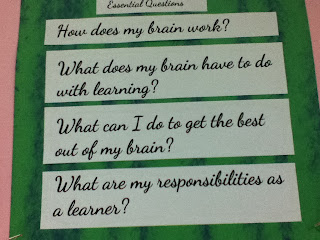This new unit, Space and Systems is the first that we have planned using our new "planner" and latest PD from Kath Murdoch in October. We have developed our own inquiry cycle, loosely UbD - but with a greater emphasis on Kath Murdoch's Inquiry Cycle since Kath is our visiting consultant helping us put everything in place.
In the past, our planners were pretty much all filled out before the unit started, except for student questions and action.
Our new planner has our standards and benchmarks and a summary to start us off. We developed the Enduring Understanding and Essential Questions and listed the skills and knowledge that we are expecting students to acquire. We discussed and came up with the criteria that would be assessed to decide whether students were successful in their learning.
We created a "compelling question" which acts as an overview of the whole unit.
And we covered as much of the classroom walls as we could with black paper.
After that the next step was planning the Tuning In. Our school has just purchased the whole set of International Primary Curriculum units of work. Our school administration has hired many PYP and other inquiry teachers who are able to take the best bits of the IPC units and use them in a way that fits what we are doing. We didn't like the Entry Point in the unit "Space Explorers" but we did like the tuning in activities, what they call the Knowledge Harvest.

Instead we used Steve Box's idea of playing the Star Wars theme as our Entry Point. Students posted thinking and wondering on a pin board.
Then, we used the IPC activity where groups had a set of cards with facts, some correct some incorrect, e.g "Astronauts can only fly to the moon when it is full," and "Revolve and rotate mean the same thing." They had to sort the cards into True, False and Not Sure, and then explain their thinking. The sets of cards can be rearranged as thinking changes duing the unit.
After that, students were given tasks ceveloped by team mate Peter Gibson:
They were asked to post their thinking on 3 walls in Wallwisher. They could read the other posts and re-post their ideas if they changed their minds. They could use whichever language they were most confident with. On one Wall they were asked to make a list of all the planets in the Solar System. On another Wall they were asked to say what the term Solar System meant to them. They could also use black paper and chalks, pastels or cut paper to create a view of the Solar System.
On another wall they were asked to comment on the compelling question.
 |
| Thnking from the class next door. |
Next day there was another Wall question. "What cycles are associated with Earth's place in space?" They were to choose a cycle with a partner and explain it to our 1st grade buddies next day. They had to make a quick plan of materials they would need to make models. Library books were to hand for checking accuracy of thinking. Even though this was originally a 3rd grade unit, I could see that these were misconceptions. It was important not to pass these on to the gr 1 buddies.
Do these activities give us evidence of understanding? We also had the students' individual blog posts.
 |
| Interesting that the writer is evaluating the learning of the Grade 1 buddies! |
And the Grade 1 tweets.
The next planning meeting will be to decide the next steps based on the prior knowledge we have discovered and the wonderings that have come out of our preliminary work.
But now.....time for a holiday!




































